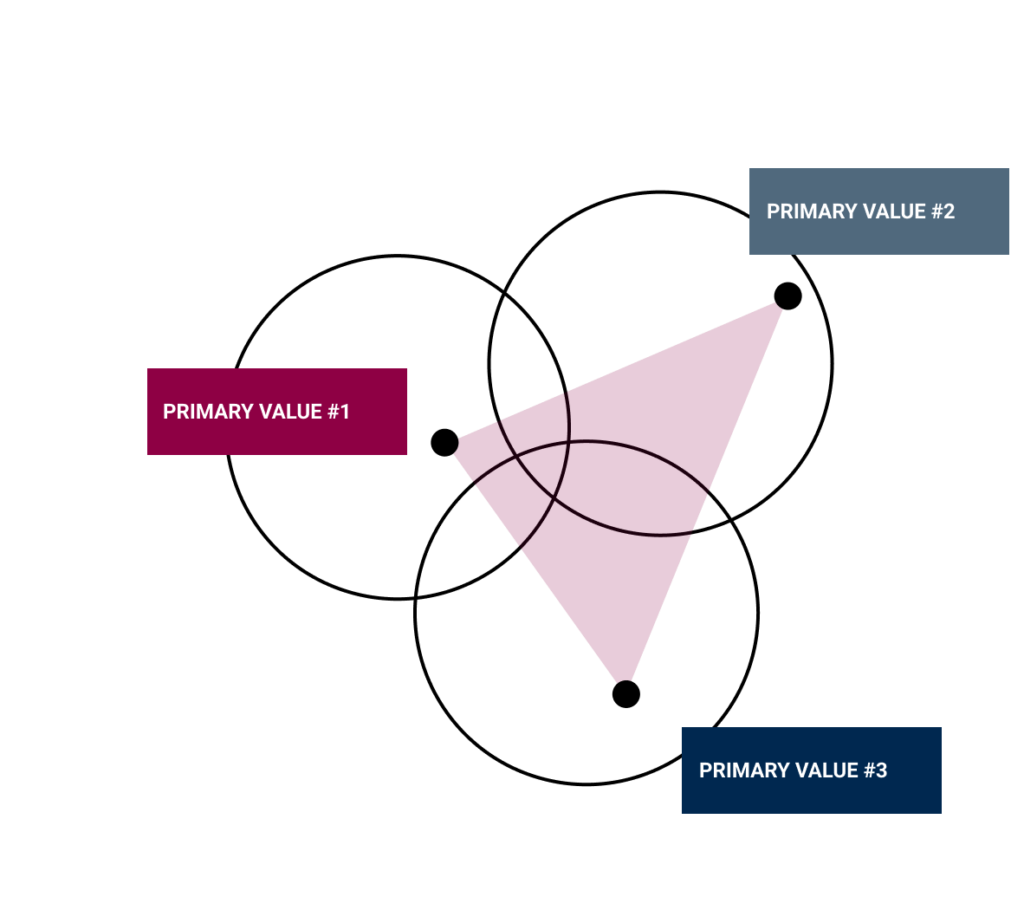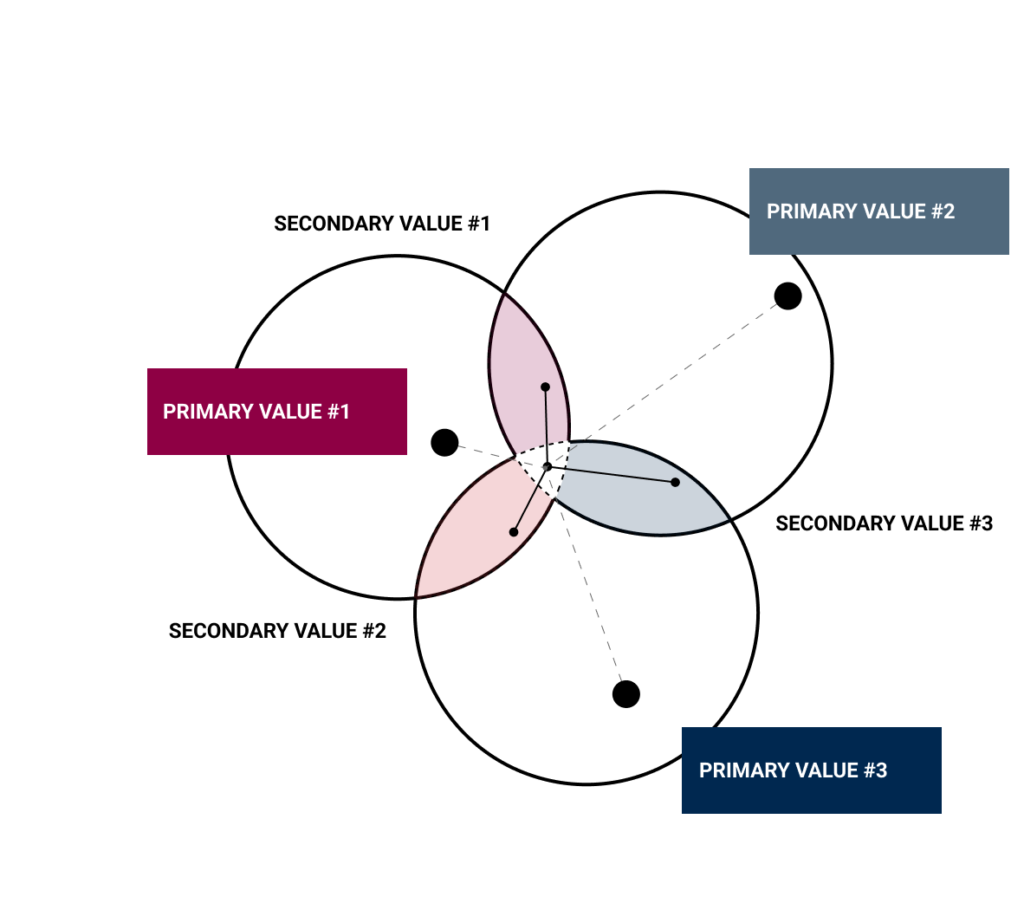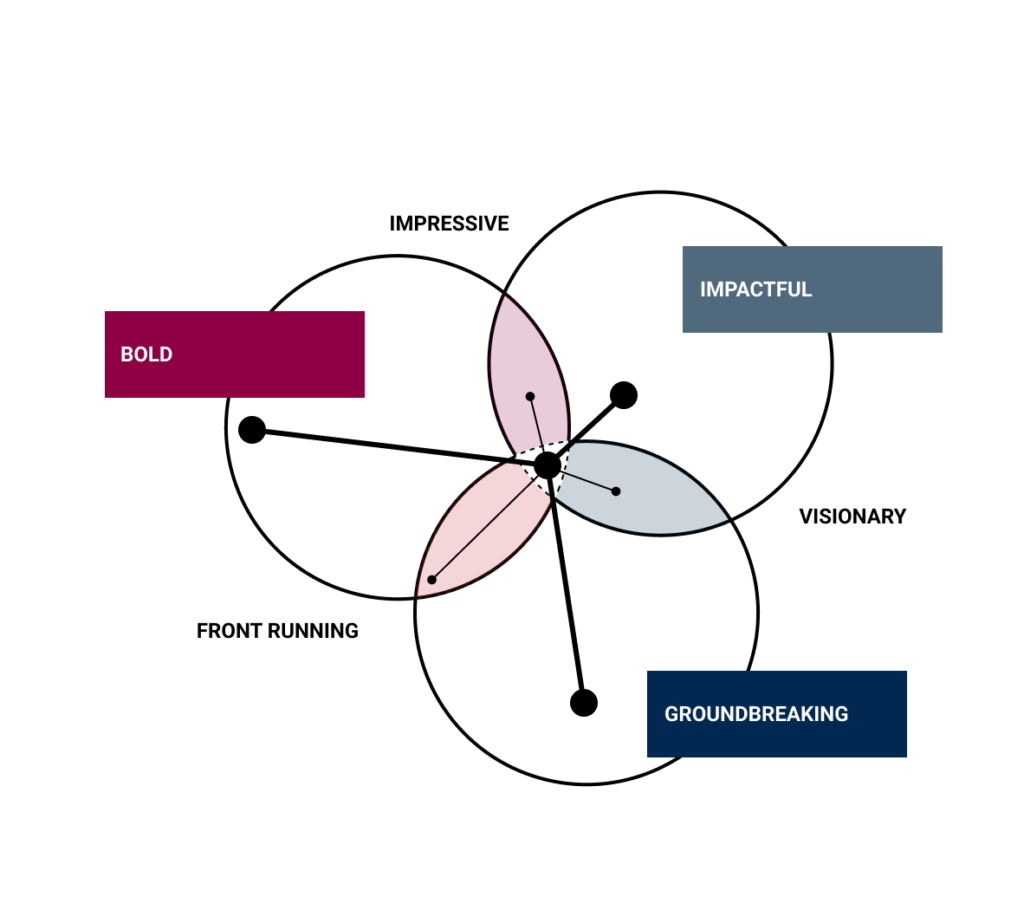Triple Constraint

The Triple Constraint is a model to help defining core values of your organization and communicate their evolution efficiently through time.
WHAT IS IT
The Triple Constraint Model is a model developed specifically to help organizations identify and visualize Core Values.
Core Values are one of the fundamental building block of a well-formed Value Proposition.
These three main blocks are:
-
The Core Values (CVs)
-
The Promise (P)
-
The Unique Selling Proposition (USP)
Aside from other models, the Triple Constraint model is a “constraint model” which means that once you agree on playing by its structure, all the consequential outcomes deriving from it (such as the Value Strategy) need to be coherent with that choice.
Its main characterization is to be a vector-driven visualization: each core value is represented as a vector, with a distance from the center of the diagram (a force) and a meaningful direction.
The resulting force diagram represents the whole Core Values System of your organization and can be therefore visualized, shared, and tracked through time, cycle after cycle.
WHY IT IS RELEVANT
Traditional brands live off old ideas. Power brands live off strong, bold values that captivate consumers and create intense brand loyalty. To create power brands, organizations need to rethink their business strategy – because it’s not about the offering, it’s about the strategy.
Core Values are the foundation of a Value Proposition, their identification is not about just choosing or betting on some values to communicate with your marketing, but something deeper and identitarian, it’s about what we are, and what we want to become.
To see if you have what it takes to turn your brand into a power brand, ask yourself these short questions:
-
- How important is it for you to think differently than everyone else?
- How often do you ask customers what else? when do they ask you what else?
- How much effort are you willing to put into customer service?
- What percentage of revenue do you spend on advertising?
- What would you do if your company didn’t make money next year?
These are just quick questions to spark discussion on why we do things and why we do things in this or that way, but in the real world, a systematic process to identify and share core values within the organization is definitely needed.
The Triple Constraint Model forces you to narrow down the set of Core Values to only three items, following the principle that with a limited choice it’s easier to tune down complexity. At the same time, secondary values cannot be freely picked but must be derived only from the intersection between two parents’ primary values.
Given this visualization, each value can have a different vector distance from the center and a different relative distance from other values. These vector distances can express the nuances of your Value Strategy when, during a specific timeframe, you need to lean more toward one single Value rather than the others.
The last axiom is a constraint created to ease the planning and the execution of your strategy throughout sequential phases:
Given three primary values, every planned action must be aligned with at least a pair of primary values.
Aligning with all three primary values is difficult and sometimes could have a negative effect on your strategy, hence the name of Triple Constraint.
USE IT FOR
When envisioning the capabilities of your peers or teams are limited and structural constraints can help them visualize better their Core Values. A visual representation always speaks louder than words and this model will be a way to enforce alignment between top management and share the direction or the evolution of the Value Strategy.
The Triple Constraint Model is also a powerful tool to guide design and communication providers in addressing consistency: without limiting their creativity, they can explore anything in between the space set by primary values.
Words have meaning, by giving a well-defined space to work with, to imagine with it, you have just created a set of implicit guidelines to adhere to.
Eg: You need to define the Branding of a new business line, how do you write the right brief for the brand agency?
…By creating a playground, just like this.

Now, let’s evolve your Value Strategy: how can you be sure that any action in your customer journey feels connected and consistent with your Value Proposition?
In each phase of your customer journey, as a designer, you must rely on core values, but with the Triple Constraint, you should only choose just a single pair of primary core values.
If you need to design an action to onboard your customer, now you have a streamlined choice: you can design anything you want, but it needs to be aligned with Value #1, Value #2, or both. Every action in the onboarding phase must be consistent with this simple rule, until the next strategic plan.

REQUIREMENTS
-
Key People
Gather key people accountable for deciding the vision according to the scope. C-Levels are required to decide values that will set the course of the organisation for the next strategic plan, D-Levels and Managers are required if the scope level is bound to a business line, Managers and Product Owners if values refer to a product.
-
A Workshop Space
To define Core Values, a workshop or a brainstorming session works best. Be sure to have a large table or a big wall as a working canvas to work respectively with cards or post-its.
-
External Data and POVs
Bring at the discussion external points of view from outside your organisation, such as competitor analysis, survey, and other researches. External data can be used to inspire, inform or even challenge internal belief and avoid hindsights.
STEP BY STEP
-
Preparation
Be sure that all participants have a basic knowledge of what is a Value Proposition and a Core Value. Prepare the workshop space: a space where all participants can gather around and see the output in progress will work best.
-
List all the Values that can be applied to your brand
Think about all positive attributes and values your brand should communicate to describe itself. If the list counts more than ten items, try to identiify a minimum common shared set, discarding all items that cannot be applied to all your offerings. Use these key questions to guide the facilitation:
- Who we are?
- Who we are not?
- Who we want to be?
-
Order all items by priority
Take all your items, order them from the top using a priority or an importance criteria: the more suitable, fittable, justified for you. Words have meaning, don't force a categorization or clustering of terms if nuances are important.
-
Narrow Down Core Values
Take the first five items from the top from the list and discuss with your peers. Narrow down the total number of values to a set of 3 items, these are interesting candidates for your Core Values, since they are the most relevant and the most recognizable for your brand or organization. This will help you stay focused and more precise in your strategy.
-
Place and Weight in Distances
Using the Triple Constraint Model, place the three primary Core Values inside the respecitves area of influence, and brainstorm with the team about their distance from the center and their orientation. See the reference for a complete example.
-
Derive Secondary Values
Using the remining items from the list to help yourself try to identify secondary core values. Secondary Values must share a common ancestor between a pair of primare Core Values, by doing this, you can expand the semantic space of your values, without compromising the structure. Focusing on just 3 by 3 values structure, the model will keep manageable the exceution complexity when planning the strategy.
-
Create Hierarchy and Relationships
Once you created a global vision of your values ecosystem it's time to build a hierarchy. Identify fil-rouge between values in order to highlight relationships, hierarchies and causations.
-
Distill principles and share
Distill 1-2 guiding principles per each relevant value cluster. This will help you stay consistent and ensure the brand values are well implemented across your business.
Share model with key people and principles with service providers. -
Track and Maintain
The Triple Constraint Model is a "live" model, it needs to be adjourned from time to time, every strategic plan cycle, to give at a glance the shift in direction of your organization values. Track the direction and the distance between vectors, long of a Triple Constrant model of your competitors to understand where they are headed.
PLAY WITH EXAMPLES
Reference

Start with a visualization of the influence areas for the three main core values.
As the basic standard layout, there is no need to be precise, just be sure all intersections are equally spaced, organized from the center, with the same workable size.
This basic layout is usually called “the flower” for its resemblance.

Place your three Core Values inside the respective areas.
Each value is represented by a dot and it can be placed anywhere inside the circle: the more they are distant from the center, the more they are important and relevant for you and your team.
Direction-wise, each dot can be closer or farther from the others, two values may be semantically or conceptually closer to each other, for example, “efficacy” and “efficiency“, or “agility” and “responsive“.

Secondary values need to lie inside the intersection of the two parent primary values, one for each intersection of the “flower“.
The same rule applies to secondary dots: they are essentially vectors, thus they need to be modeled in respect of the direction and the strength of their parents: strong primary values sustain strong secondary values.
Of course, secondary values cannot be stronger than their parents, by definition, and also their direction is strictly limited to a loose average of their parents.

This is a full representation of the Triple Constraint Model, making it obvious why we are used to calling this type of diagram “flower“.
With little-to-none description, it can be shared with the organization and third parties.
Be sure to start versioning this diagram for each strategic plan cycle: it’s quite common to change the weights of core values, by changing their distance or direction over time, however, is acceptable to phase out a single core value from cycle to cycle, but it is far less common to overhaul the entire core values set at the same time.






